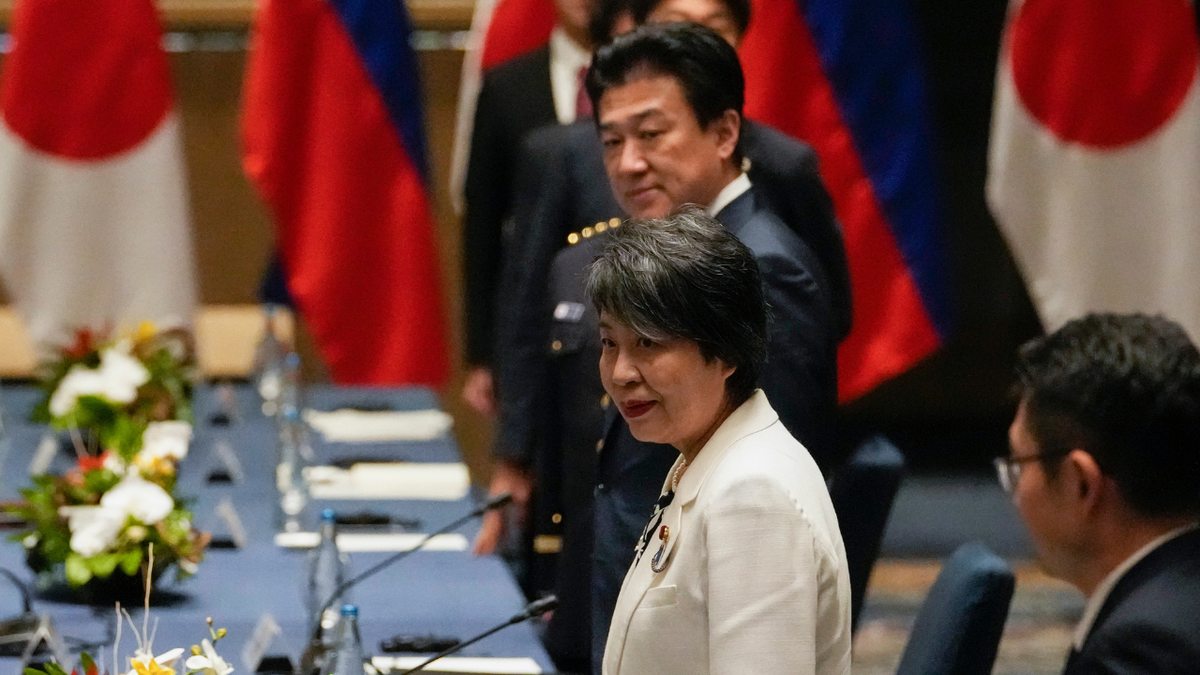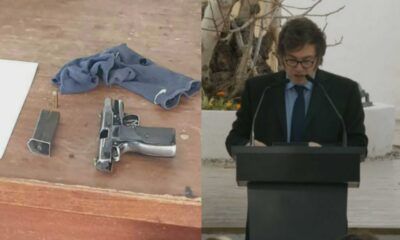INTERNACIONAL
The history of the scant 2-piece bikini dates back nearly 80 years, designed to draw attention, horror

The modern bare-backed bikini, though decorated with a unique tie or charm, is nearly identical to the creation of the first official risqué two-piece set from the 1940s, which turned both women and men off from the sight of it for almost two decades due to lack of conservativeness.
On July 5, 1946, 18-year-old French exotic dancer Micheline Bernardini brazenly donned the first black and white bikini of its nature during a press conference at a public swimming pool in Paris.
Louis Réard, a prestigious French mathematician-turned-clothing designer, pieced together the bikini design women have wiggled into for nearly 80 years with the intent of drawing attention. He hoped the bikini featuring newspaper clippings would strike as much shock and horror as the atomic bomb from 1945. The leaf-stopping photographs of Bernardini published on the front page of newspapers did just that.
NATIONAL BIKINI DAY: 5 THINGS YOU DIDN’T KNOW ABOUT THE SKIMPY TWO-PIECE SWIMSUIT
Louis Réard designed the first two-piece bathing suit where the bottoms cut below the navel. French exotic dancer Micheline Bernardini was hired to wear the bikini in front of journalists on July 5, 1946. (Photo by Bettmann via Getty Images | Photo by Keystone-France/Gamma-Keystone via Getty Images)
Réard hired Bernardini to saunter around in front of cameras in his G-string bottom and triangle top design when professional runway models refused to rock the next-to-nothing swimsuit.
Bernardini received around 50,000 fan letters, mostly from men, following the news coverage of the ordeal, according to History.com
The design devoid of much fabric was labeled «bikini» by Réard after the nuclear warhead test happened off the tiny island of Bikini Atoll in the Pacific Ocean earlier that week.
Though the adoration for Bernardini in 30 inches of cotton and jersey rolled in quickly, Réard’s design struggled to strike a chord with American wearers until the 1960s. In the 1950s, European women began wearing the scant bikini, though Spain and Italy banned the suit style on public beaches in the early 1950s.
The skimpiness of the bathing suit was in part due to material rationing during World War II.
SI SWIM SEARCH FINALIST KRISTEN LOUELLE GAFFNEY, MOM OF TWO, UNVEILS CURVES ON MIAMI RUNWAY: ‘MAGICAL MOMENT’

French exotic dancer Micheline Bernardini was hired when professional runway models refused to wear the scant two-piece in public. She received nearly 50,000 fan letters after photographs of her were printed. (AFP via Getty Images)
WWII placed a heavy burden on rationing of supplies across the U.S. and Britain, and restrictions on items including food, shoes and fabrics, among other supplies, were put in place to conserve.
In order to purchase items that were rationed, individuals had to both pay for food and materials, and also provide «points» at the time of purchase. Points were issued to people, including babies, in the form of blue and red stamps for a variety of selected items.
If an item was easily accessible but rationed, it cost fewer points than an item in high demand. In 1943, one pound of bacon cost 30 cents and 7 points, according to the National WWII Museum.
In terms of clothing, Britain rationed fabrics in 1941. A woman’s dress cost 11 points, and 8 points were required for a man’s shirt, according to the Imperial War Museum’s website.
The length of men’s shirts was restricted and double cuffs on collared shirts were banned altogether. Additionally, prices of clothing rose and fabrics were limited. Some textiles, including silk, were made entirely unavailable to designers and manufacturers.
SI SWIMSUIT COVER GIRL BROOKS NADER REVEALS HER SECRET TO STAYING BIKINI-READY

Nearly 80 years after the first two-piece bikini was revealed and subsequently banned on some European beaches, the swimsuit remains popular among women around the world. (Alexander Tamargo/Getty Images for Sports Illustrated)
At the time, women’s fashion was not a priority, and the selection of clothing for women was scarce. As civilians remained dedicated to fashion, they made do with what was available and affordable.
As the British and American governments continued their efforts to conserve for their nations, designers like Réard pivoted design and marketing strategies to appeal to audiences and used raw materials and resources like cotton to create stylized apparel that still met ration requirements – hence the bikini.
When WWII ended, the rationing program did, too, but the bikini stuck around.
While Réard provided the namesake, bikini drama and an audience for Bernardini, his design was not the first two-piece swimsuit available to sunbathers, though it was the first to be cut below the navel.
In 1946, fashion designer Jacques Heim, and rival to Réard, revealed what he called the «smallest bathing suit in the world» and named it Atome for its size. However, his first designs were revealed in the 1930s.
CLICK HERE TO GET THE FOX NEWS APP
Heim hoped to create the same level of excitement surrounding the itsy bitsy beach apparel as the explosion of an atomic bomb, according to the Museum of Jewish People.
Though women have appeared poolside in bikinis for nearly eight decades, the swimsuit remains a flagrant and attention-grabbing summer accessory.
INTERNACIONAL
Japan and Philippines sign defense agreement prompted by concerns over China

- Japan and the Philippines have signed a defense pact allowing Japanese forces to conduct joint drills in the Philippines.
- The Reciprocal Access Agreement permits Filipino forces to train in Japan.
- China is warning Japan it should «seriously reflect on its history of aggression» in the region.
Japan and the Philippines signed a key defense pact Monday allowing the deployment of Japanese forces for joint drills in the Southeast Asian nation that came under brutal Japanese occupation in World War II but is now building an alliance with Tokyo as both face an increasingly assertive China.
The Reciprocal Access Agreement, which similarly allows Filipino forces to enter Japan for joint combat training, was signed by Philippine Defense Secretary Gilberto Teodoro and Japanese Foreign Minister Yoko Kamikawa in a Manila ceremony witnessed by President Ferdinand Marcos Jr. It would take effect after ratification by the countries’ legislatures, Philippine and Japanese officials said.
Kamikawa called the signing «a groundbreaking achievement» that should further boost defense cooperation between the countries.
US, AUSTRALIA, JAPAN AND PHILIPPINES VOW TO DEEPEN DEFENSE COOPERATION AMID SOUTH CHINA SEA TENSIONS
The Japanese and Philippine officials «expressed serious concern over the dangerous and escalatory actions by China» in Second Thomas Shoal, the scene of a recent confrontation between Chinese and Philippine forces in the South China Sea. The busy sea passage is a key global trade route which has been claimed virtually in its entirety by China but also contested in part by the Philippines, Vietnam, Malaysia, Brunei and Taiwan.
From left, Japan Defense Minister Minoru Kihara, Japan Foreign Minister Yoko Kamikawa, Philippines’ Foreign Secretary Enrique Manalo and Philippines’ Defense Secretary Gilberto Teodoro Jr. join hands as they pose after a press conference at a hotel in Taguig, Philippines, on July 8, 2024. Japan and the Philippines have signed a defense pact allowing their troops to enter each other’s country for joint military training. (AP Photo/Aaron Favila)
They underscored in a joint statement the need «for the international community to speak out on the importance of maintaining and strengthening the free and open international order based on the rule of law» in the disputed waters.
In Beijing, Foreign Ministry spokesperson Lin Jian said «the Asia-Pacific region does not need military blocs, let alone small groupings that instigate bloc confrontations or a new Cold War» and reminded Japan of its atrocities during World War II in Southeast Asian countries, including the Philippines.
«Japan should seriously reflect on its history of aggression and act cautiously in the field of military security,» the spokesperson said.
The defense pact with the Philippines, which includes live-fire drills, is the first to be forged by Japan in Asia. Japan signed similar accords with Australia in 2022 and with Britain in 2023.
Under Prime Minister Fumio Kishida, Japan has taken steps to boost its security and defensive firepower, including a counterstrike capability that breaks from the country’s postwar principle of focusing only on self-defense. It’s doubling defense spending in a five-year period to 2027 to bolster its military power and make Japan the world’s third-biggest military spender after the United States and China.

Japan Foreign Minister Yoko Kamikawa, second from right, and Japan Defense Minister Minoru Kihara wait for their counterparts to arrive prior to their meetings to discuss bilateral ties and defense, as well as regional security, at a hotel in Taguig, Philippines, on July 8, 2024. (AP Photo/Aaron Favila)
Many of Japan’s Asian neighbors, including the Philippines, came under Japanese aggression until its defeat in World War II, and Tokyo’s efforts to strengthen its military role and spending could be a sensitive issue. Japan and the Philippines, however, have steadily deepened defense and security ties.
Kishida’s moves dovetail with Marcos’ effort to forge security alliances to bolster the Philippine military’s limited ability to defend its territorial interests in the South China Sea.
The United States has also been strengthening an arc of military alliances in the Indo-Pacific to better counter China, including in any future confrontation over Taiwan, and reassure its Asian allies. Japan and the Philippines are treaty allies of the U.S. and their leaders held three-way talks in April at the White House, where President Joe Biden renewed Washington’s «ironclad» commitment to defend Japan and the Philippines.
CHINESE AMBITIONS FOR US ALLIES PROMPTS WASHINGTON SECURITY SUMMIT WITH JAPAN, PHILIPPINES
Japan has had a longstanding territorial dispute with China over islands in the East China Sea. Chinese and Philippine coast guard and navy ships, meanwhile, have been involved in a series of tense confrontations in the South China Sea since last year.
In the worst confrontation so far, Chinese coast guard personnel armed with knives, spears and an ax aboard motorboats repeatedly rammed and destroyed two Philippine navy supply vessels on June 17 in a chaotic face-off at disputed Second Thomas Shoal that injured several Filipino sailors. Chinese coast guard personnel seized seven navy rifles.

Japan Foreign Minister Yoko Kamikawa and Philippine Defense Secretary Gilberto Teodoro shake hands after signing the reciprocal access agreement at the Malacanang Palace in Manila, Philippines, on July 8, 2024. (Lisa Marie David/Pool Photo via AP)
The Japanese and Philippine officials said China’s actions at the shoal «obstructed freedom of navigation and disrupted supply lines, thus, increasing tensions.»
Kihara said in a news conference that Japan «has firmly opposed the dangerous and coercive use of maritime security agencies and maritime militia vessels.»
The Philippines strongly protested the Chinese coast guard’s actions and demanded $1 million for the damage and the return of the rifles. China accused the Philippines of instigating the violence, saying the Filipino sailors strayed into what it called Chinese territorial waters despite warnings.
CLICK HERE TO GET THE FOX NEWS APP
Japan and the United States were among the first to express alarm over the Chinese actions and call on Beijing to abide by international laws. Washington is obligated to defend the Philippines, its oldest treaty ally in Asia, if Filipino forces, ships and aircraft come under an armed attack, including in the South China Sea.
-
POLITICA2 días ago
Detuvieron a un hombre armado a metros del acto de Milei en San Juan
-
POLITICA1 día ago
En Brasil aseguran que el gobierno podría retirar a su embajador en Buenos Aires si Javier Milei ofende a Lula en su discurso en el encuentro organizado por los Bolsonaro
-
POLITICA3 días ago
El Gobierno busca bajar la tensión con el PRO y dice que cumplirá el fallo por la coparticipación a la Ciudad que reclamó Macri
-
POLITICA3 días ago
Caso Loan: incidentes en la puerta del Juzgado Federal tras la detención de Laudelina Peña
-
INTERNACIONAL18 horas ago
Elecciones en Francia: qué escenarios políticos se abren ahora tras el triunfo de la izquierda
-
POLITICA13 horas ago
Caso Loan: la hija de Laudelina denunció sobornos y amenazas





























